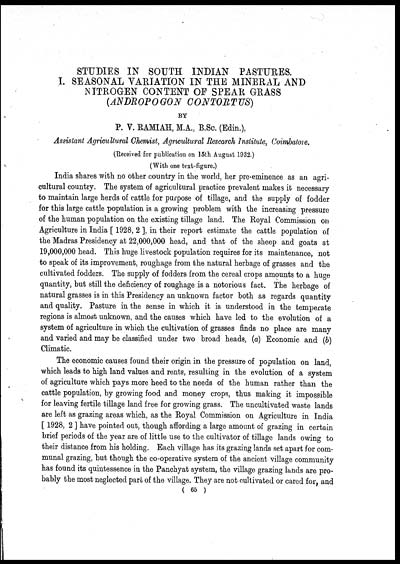Medicine - Veterinary > Veterinary colleges and laboratories > Indian journal of veterinary science and animal husbandry > Volume 3, 1933 > Original articles > Studies in South Indian pastures. I. Seasonal variation in the mineral and nitrogen content of spear grass (Andropogon contortus)
(101) Page 65
Download files
Individual page:
Thumbnail gallery: Grid view | List view

STUDIES IN SOUTH INDIAN PASTURES.
I. SEASONAL VARIATION IN THE MINERAL AND
NITROGEN CONTENT OF SPEAR GRASS
(ANDROPOGON CONTORTUS)
BY
P. V. RAMIAH, M.A., B.Sc. (Edin.),
Assistant Agricultural Chemist, Agricultural Research Institute, Coimbalore.
(Received for publication on 15th August 1932,)
(With one text-figure.)
India shares with no other country in the world, her pre-eminence as an agri-
cultural country. The system of agricultural practice prevalent makes it necessary
to maintain large herds of cattle for purpose of tillage, and the supply of fodder
for this large cattle population is a growing problem with the increasing pressure
of the human population on the existing tillage land. The Royal Commission on
Agriculture in India [ 1928, 2 ], in their report estimate the cattle population of
the Madras Presidency at 22,000,000 head, and that of the sheep and goats at
19,000,000 head. This huge livestock population requires for its maintenance, not
to speak of its improvement, roughage from the natural herbage of grasses and the
cultivated fodders. The supply of fodders from the cereal crops amounts to a huge
quantity, but still the deficiency of roughage is a notorious fact. The herbage of
natural grasses is in this Presidency an unknown factor both as regards quantity
and quality. Pasture in the sense in which it is understood in the temperate
regions is almost unknown, and the causes which have led to the evolution of a
system of agriculture in which the cultivation of grasses finds no place are many
and varied and may be classified under two broad heads, (a) Economic and (b)
Climatic.
The economic causes found their origin in the pressure of population on land,
which leads to high land values and rents, resulting in the evolution of a system
of agriculture which pays more heed to the needs of the human rather than the
cattle population, by growing food and money crops, thus making it impossible
for leaving fertile tillage land free for growing grass. The uncultivated waste lands
are left as grazing areas which, as the Royal Commission on Agriculture in India
[ 1928, 2 ] have pointed out, though affording a large amount of grazing in certain
brief periods of the year are of little use to the cultivator of tillage lands owing to
their distance from his holding. Each village has its grazing lands set apart for com-
munal grazing, but though the co-operative system of the ancient village community
has found its quintessence in the Panchyat system, the village grazing lands are pro-
bably the most neglected part of the village. They are not cultivated or cared for, and
(65)
Set display mode to: Large image | Zoom image | Transcription
Images and transcriptions on this page, including medium image downloads, may be used under the Creative Commons Attribution 4.0 International Licence unless otherwise stated. ![]()
| Permanent URL | https://digital.nls.uk/75229665 |
|---|
| Description | Covers articles from 1933. |
|---|




